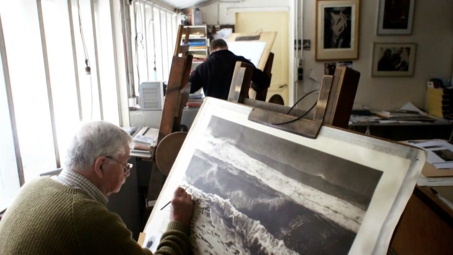The Fresson process
From the film's opening frames, Thomas Goupille plunges us into another world and another time: the workshop of the famous Fresson dynasty, master printers of photographs since 1899. The enlarger and the wooden frames from the nineteenth century, the Roberval balance, now only found at antique dealers, kitchen pans, as well as the machine that spreads gelatine on the paper, invented by great-grandfather along with the process: these are still working instruments. But by etching their era and their technical protocols in the printing process, they anchor the Fressons in the field of artistic craftsmanship, in the wake of a family tradition of quality, creativity and unique pieces, in contrast to a contemporary world sucked in by quantity, technological productivity and profit.
In the Fresson workshop, snapshot adjustments are made at a glance, exposure times are gauged by instinct, images are revealed (in broad daylight) over large tubs by pouring pans full of developer onto the emulsified paper, then (on a case-by-case basis) direct intervention by hand or sponge on the delicate areas of the picture. Each image is unique: "No two copies the same."
Everything began with great-grandfather Théodore-Henri Fresson (1865-1951), who invented and patented the "Fresson process" at the Société française de photographie at the turn of the 20th century, in 1899. But this fruit of the ancestor's inventiveness has been perpetuated, transformed, disseminated, and protected (part still remains secret today). The "Fresson process" of photographic printing on paper is now known throughout the world of photography, from the pictorialists of the early years to contemporary photographers and artists.
Initially limited to black-and-white prints, the process was adapted to colour photos in 1952 with rendering that was both exceptional and yet quite identifiable, like an aesthetic signature of the Fresson process. But colour added new depth to the constraints by requiring four successive layers of emulsion sensitive to cyan, yellow, magenta (the three subtractive primary colours) and black to the same sheet of paper. This included thoroughly rinsing and drying the sheets of paper between each layer. Thomas Goupille's film shows each of these stages in full.
After printing, the image is touched up, even altered, also by hand, to correct possible imperfections or modify the colours of certain zones. In all, printing operations for a colour photograph by the Fresson workshop take two to three weeks of work done totally by hand: a seemingly impossible trade-off between a "crazy job" and the "satisfaction of a job well done" (Jean-François Fresson).
This gamble combines a series of challenges: that of maintaining the reputation of the "Fresson process"; ensuring economic profitability via a traditional way of producing unique pieces; to make changes to a process that is both relatively uncontrollable and easily identified; to compensate for the disappearance of essential products such as certain papers; to remain faithful to a meaningful family venture; ... as well as the challenge of an uncomprehending public accustomed to looking at images on a computer screen to the point of having "lost the notion of imperfection linked to film and the element of chance involved in the process". Faced with these cumulative challenges, Jean-François Fresson suggests that "maybe things will get better when IT fails" — a hypothetical prospect!
André Rouillé, February 2021
Translated from French by Mark Goodwin



